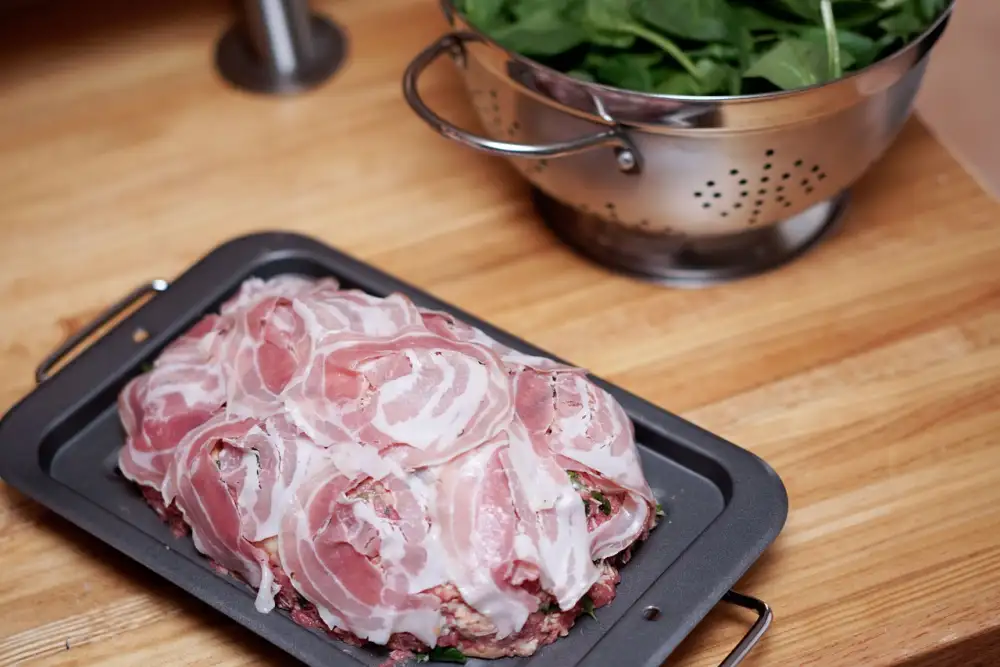Indulge in the Savory Delights of Pancetta: Exploring the Art of Italian Cured Meat

- Introduction to Pancetta
- Origins and History of Pancetta
- Traditional Preparation and Curing Process
- Varieties of Pancetta
- Culinary Uses and Recipes with Pancetta
- Nutritional Value and Health Benefits of Pancetta
- Tips for Buying and Storing Pancetta
- Pairing Pancetta with Other Ingredients
- Exploring Regional Pancetta Dishes in Italy
- Conclusion: Celebrating the Flavors of Pancetta
Introduction to Pancetta
Pancetta, a beloved Italian cured meat, is a true delight for the senses. Made from pork belly, pancetta is known for its rich flavor and delicate texture. It is often compared to bacon, but pancetta offers a distinct taste that sets it apart. Whether enjoyed on its own or used as an ingredient in various dishes, pancetta adds depth and complexity to any culinary creation. Join us on a journey as we explore the artistry of this exquisite Italian delicacy.
Origins and History of Pancetta
Pancetta, a beloved Italian cured meat, has a rich history that dates back centuries. Its origins can be traced to ancient Rome, where it was known as "panus" or "pansum." The word "pancetta" itself is derived from the Italian word "pancia," meaning belly, which refers to the cut of pork used to make this delectable treat.
Historically, pancetta was created as a way to preserve pork before the invention of refrigeration. It was salted and seasoned with aromatic herbs such as black pepper, garlic, and fennel seeds. The curing process allowed the meat to develop its distinct flavor profile and tender texture.
Over time, pancetta became an integral part of Italian cuisine. It gained popularity in various regions across Italy, each adding its own unique twist to the preparation and seasoning. Today, it is widely recognized as one of Italy's most iconic cured meats.
The art of making pancetta has been passed down through generations, with each family having its own closely-guarded recipe and curing techniques. While traditional methods are still followed today, modern advancements have made the process more efficient without compromising on taste or quality.
As pancetta continues to be cherished by food enthusiasts around the world, its history serves as a testament to the enduring appeal of this exquisite Italian delicacy.
Traditional Preparation and Curing Process
Traditional Preparation and Curing Process:
Pancetta, a beloved Italian cured meat, is made from pork belly that is carefully seasoned and cured. The traditional preparation of pancetta involves rubbing the meat with a mixture of salt, black pepper, garlic, and various aromatic herbs such as rosemary and thyme. This process helps to enhance the flavor profile of the meat.
After seasoning, the pork belly is tightly rolled into a cylindrical shape and tied with string to maintain its form during the curing process. It is then left to cure for several weeks or even months in a cool environment. During this time, the flavors intensify and develop, resulting in a rich and savory taste.
The curing process is crucial in creating the unique texture and flavor of pancetta. It allows the meat to slowly dry out while retaining its natural moisture. This results in a firm yet tender consistency that melts in your mouth when cooked.
Traditionally, pancetta was cured by hanging it in well-ventilated areas such as cellars or attics. However, modern methods also include vacuum-sealing or using temperature-controlled curing chambers to ensure consistent results.
The length of the curing process can vary depending on personal preference and regional traditions. Some prefer a shorter cure for milder flavors, while others opt for longer cures for a more intense taste.
The art of preparing pancetta has been passed down through generations in Italy, with each family having their own secret recipes and techniques. This dedication to tradition ensures that every slice of pancetta offers an authentic taste experience that has been perfected over centuries.
Varieties of Pancetta
Pancetta, the Italian cured meat, comes in various regional varieties that showcase the diverse flavors and techniques used across Italy. The most well-known variety is Pancetta Piacentina, hailing from the Emilia-Romagna region. It is made with pork belly seasoned with salt, pepper, garlic, and other spices before being rolled and cured for several months.
Another popular type is Pancetta di Calabria from southern Italy. This variety is typically spicier, infused with chili flakes or fennel seeds during the curing process. Its bold and fiery flavor adds a delightful kick to dishes.
In central Italy, Pancetta Toscana is highly regarded. It is characterized by its aromatic blend of herbs such as rosemary, sage, and thyme. The herbs are rubbed onto the pork belly before it undergoes the curing process, resulting in a fragrant and savory pancetta.
Lastly, Pancetta Affumicata deserves a mention for its unique smoky flavor. This variety is cold-smoked over wood chips before being cured. The smoking process adds depth and complexity to the already rich taste of pancetta.
With these different varieties available, chefs and home cooks have a wide range of options to experiment with when incorporating pancetta into their culinary creations.
Culinary Uses and Recipes with Pancetta
Culinary Uses and Recipes with Pancetta:
Pancetta, with its rich and savory flavor, is a versatile ingredient that can elevate any dish. It adds depth and complexity to soups, stews, and sauces. One popular use is in the classic Italian pasta dish, carbonara. The crispy pancetta bits are mixed with eggs, cheese, and pasta to create a creamy and indulgent sauce.
Another delicious way to enjoy pancetta is in salads. Crumble it over fresh greens for an added burst of flavor or wrap it around vegetables like asparagus or zucchini before grilling. The smoky taste of the pancetta pairs perfectly with the charred veggies.
For a unique twist on pizza, try topping it with thin slices of pancetta along with your favorite ingredients. The salty meat adds a delightful contrast to the other flavors.
Pancetta also shines when used as a stuffing for meats like chicken or pork. Its fatty richness keeps the meat moist while infusing it with incredible flavor.
Incorporating pancetta into your cooking opens up endless possibilities for creating delicious meals that will delight your senses. Try experimenting with different recipes and let the savory delights of pancetta take center stage in your culinary creations.
Nutritional Value and Health Benefits of Pancetta
Pancetta, with its rich flavor and melt-in-your-mouth texture, is not only a delight for the taste buds but also offers some nutritional value. While it is important to consume pancetta in moderation due to its high fat content, it does provide a good amount of protein. It also contains essential vitamins and minerals such as vitamin B12, zinc, and iron. However, it is worth noting that pancetta is cured with salt and may contain nitrates, so individuals with certain health conditions should consume it sparingly. As with any food, balance is key when enjoying the savory delights of pancetta.
Tips for Buying and Storing Pancetta
When it comes to buying and storing pancetta, there are a few tips to keep in mind. Firstly, it is important to choose pancetta that has a vibrant red color and is marbled with white fat. This indicates that the meat is fresh and of good quality.
When purchasing pancetta, opt for whole pieces rather than pre-sliced ones as they tend to have better flavor and texture. It is also advisable to buy from reputable sources such as specialty delis or butcher shops.
To store pancetta, wrap it tightly in plastic wrap or place it in an airtight container. Keep it refrigerated at temperatures below 40°F (4°C). Properly stored pancetta can last for up to 3 months.
If you have purchased a large piece of pancetta but only need a small amount, you can slice off what you need and freeze the rest. Just make sure to wrap it tightly in plastic wrap or place it in a freezer bag before freezing.
Remember that pancetta is cured meat, so it does not require cooking before consumption. However, if you plan on using it in recipes that call for cooked pancetta, simply dice or slice it and cook until crispy.
By following these tips, you can ensure that your pancetta stays fresh and flavorful for all your culinary adventures.
Pairing Pancetta with Other Ingredients
Pancetta, with its rich and savory flavor, is a versatile ingredient that can enhance the taste of various dishes. Its distinct taste pairs well with a wide range of ingredients, adding depth and complexity to any recipe. One classic combination is pancetta and eggs, where the saltiness of the meat complements the creaminess of scrambled or poached eggs.
Pancetta also works wonders when paired with vegetables like asparagus or Brussels sprouts. The smoky and salty notes of the meat balance out the earthiness of these vegetables, creating a harmonious blend of flavors. Another popular pairing is pancetta with pasta dishes such as carbonara or amatriciana. The crispy texture and intense flavor of pancetta add a delightful twist to these traditional Italian recipes.
For those who enjoy seafood, pancetta can be used to elevate dishes like grilled shrimp or scallops. The combination of the sweet seafood flavors with the salty pancetta creates a delightful contrast that will tantalize your taste buds. Additionally, pancetta can be incorporated into salads or used as a topping for pizzas, adding an extra layer of flavor to these dishes.
When pairing pancetta with other ingredients, it's important to consider the overall balance of flavors. The saltiness and richness of pancetta should complement rather than overpower other ingredients. Experimenting with different combinations will help you discover new and exciting flavor profiles that will delight your senses.
Whether you're cooking up a hearty breakfast, preparing a delicious pasta dish, or experimenting with new recipes, don't hesitate to include pancetta in your culinary creations. Its unique taste and versatility make it an excellent choice for enhancing the flavors in any dish. So go ahead and indulge in the savory delights of pancetta – your taste buds will thank you!
Exploring Regional Pancetta Dishes in Italy
Italy is a country known for its diverse regional cuisine, and pancetta plays a prominent role in many traditional dishes. In the northern region of Lombardy, you'll find "risotto alla Milanese" - a creamy saffron-infused risotto topped with crispy pancetta. Moving south to Emilia-Romagna, "tagliatelle alla Bolognese" features pancetta as one of the key ingredients in the rich meat sauce. In Tuscany, "pappa al pomodoro" is a rustic tomato and bread soup garnished with crispy pancetta. And in the southern region of Calabria, "spaghetti alla carbonara" showcases pancetta's smoky flavor alongside eggs, cheese, and black pepper. These regional dishes highlight the versatility and exquisite taste of pancetta in Italian cuisine.
Conclusion: Celebrating the Flavors of Pancetta
In conclusion, Pancetta is a true culinary delight that brings a burst of flavor to any dish. Its rich history and traditional preparation methods make it a cherished ingredient in Italian cuisine. Whether used as a topping, wrapped around other ingredients, or incorporated into recipes, Pancetta adds depth and complexity to every bite. Its savory taste and melt-in-your-mouth texture are truly irresistible. So go ahead and indulge in the flavors of Pancetta – your taste buds will thank you!
Published: 14. 11. 2023
Category: Food



